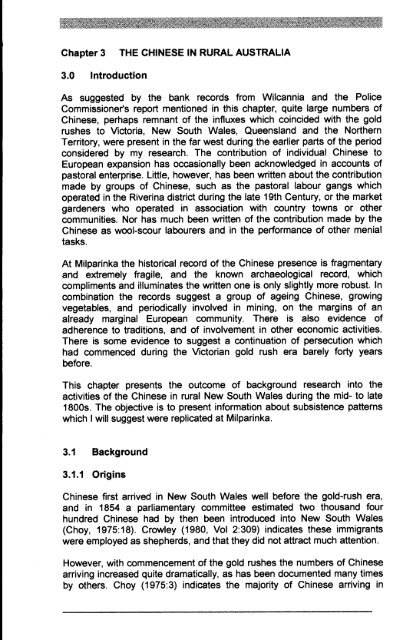Adec Preview Generated PDF File - The Sydney eScholarship ...
Adec Preview Generated PDF File - The Sydney eScholarship ...
Adec Preview Generated PDF File - The Sydney eScholarship ...
Create successful ePaper yourself
Turn your PDF publications into a flip-book with our unique Google optimized e-Paper software.
Chapter 3 THE CHINESE IN RURAL AUSTRALIA<br />
3.0 Introduction<br />
As suggested by the bank records from Wilcannia and the Police<br />
Commissioner's report mentioned in this chapter, quite large numbers of<br />
Chinese, perhaps remnant of the influxes which coincided with the gold<br />
rushes to Victoria, New South Wales, Queensland and the Northern<br />
Territory, were present in the far west during the earlier parts of the period<br />
considered by my research. <strong>The</strong> contribution of individual Chinese to<br />
European expansion has occasionally been acknowledged in accounts of<br />
pastoral enterprise. little, however, has been written about the contribution<br />
made by groups of Chinese, such as the pastoral labour gangs which<br />
operated in the Riverina district during the late 19th Century, or the market<br />
gardeners who operated in association with country towns or other<br />
communities. Nor has much been written of the contribution made by the<br />
Chinese as wool-scour labourers and in the performance of other menial<br />
tasks.<br />
At Milparinka the historical record of the Chinese presence is fragmentary<br />
and extremely fragile, and the known archaeological record, which<br />
compliments and illuminates the written one is only slightly more robust. In<br />
combination the records suggest a group of ageing Chinese, growing<br />
vegetables, and periodically involved in mining, on the margins of an<br />
already marginal European community. <strong>The</strong>re is also evidence of<br />
adherence to traditions, and of involvement in other economic activities.<br />
<strong>The</strong>re is some evidence to suggest a continuation of persecution which<br />
had commenced during the Victorian gold rush era barely forty years<br />
before.<br />
This chapter presents the outcome of background research into the<br />
activities of the Chinese in rural New South Wales during the mid- to late<br />
1800s. <strong>The</strong> objective is to present information about subsistence patterns<br />
which I will suggest were replicated at Milparinka.<br />
3.1 Background<br />
3.1.1 Origins<br />
Chinese first arrived in New South Wales well before the gold-rush era,<br />
and in 1854 a parliamentary committee estimated two thousand four<br />
hundred Chinese had by then been introduced into New South Wales<br />
(Choy, 1975:18). Crowley (1980, Vol 2:309) indicates these immigrants<br />
were employed as shepherds, and that they did not attract much attention.<br />
However, with commencement of the gold rushes the numbers of Chinese<br />
arriving increased quite dramatically, as has been documented many times<br />
by others. Choy (1975:3) indicates the majority of Chinese arriving in




